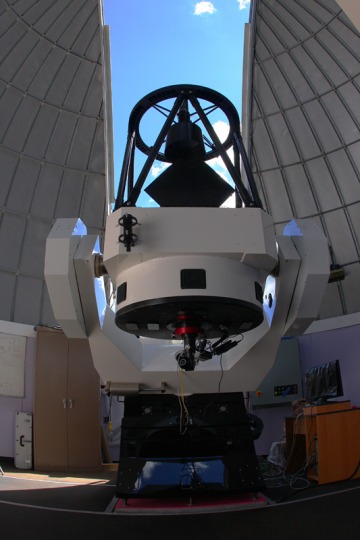Remote Astrophotography with the Schulman Telescope

Amateur astrophotographers around the world can now enjoy taking full control of the Schulman Telescope. As one of the largest dedicated public access telescopes in the United States, the 32-inch telescope was designed from inception to provide full remote control over the internet by astrophotographers worldwide. The telescope has been provided to the Mt. Lemmon SkyCenter by the Schulman Foundation, Joseph D. Schulman, President.
Individuals can take direct control of the telescope operating the instrument through a web-based interface. Real-time imaging provides feedback as to what is occurring at the observatory atop Mount Lemmon's 9,170-foot peak. You can see the images as they are acquired, watch the telescope and dome move, monitor the weather conditions, monitor guide stars, focus, and much more. It is like being there while sitting comfortably in your own home. Individuals can also elect to submit requests for data via scheduled (queued) observations.
Note that remote use of the telescope for astrophotography is not the same as live viewing and is targeted towards individuals interested in acquiring high-resolution astronomical data that have experience using photo editing software with raw astronomical images (FITS format).
To purchase time for remote astrophotography with the Schulman Telescope, please visit our Tickets webpage.
Weather cancellation and refund policy
Reservations may be canceled for any reason for a full refund up to 48 hours before your reserved time. Please email us at mtlemmon.skycenter.remote@gmail.com or call 1+ 520 626 8122. Cancellation requests inside of 48 hours are not eligible for a refund.
As the use of the telescope is weather dependent, a determination will be made on a nightly basis as to whether the Schulman Telescope will be opened for remote use. If the telescope is not opened for weather (or equipment) reasons, an email will be sent as soon as that determination is made. A full refund is available, or you may contact our office to reschedule for another available night. Time lost at the telescope due to equipment or observatory malfunction will similarly be refunded.
| Location Specifications | |
|---|---|
|
Longtitude |
-110.7889 |
|
Latitude |
32.4423 |
|
Elevation |
9157 ft. |
| Telescope Specifications | |
|
Aperture |
0.8 m |
|
Focal Length |
5.6 m *f/7 |
|
Mount |
Equatorial Fork |
Schulman Telescope and Observatory
Telescope specifications
- Diameter: 0.8m
- Focal Length: 5695mm (approximately f/7)
- Operational Hour Angle from -5.2 to +5.2
- Typical RMS guide errors 1.5 pixels (0.5 arcseconds)
- Unguided exposures possible for up to 300 second exposures
- All sky pointing: approximately 60” using T-point (1 arcsecond tolerance for final commanded position after plate solution and offset)
- Equatorial Fork mount with no periodic error (friction drive)
- Telescope slew rate: 8 degrees per second
Observatory Specifications
- Percentage of usable nights between September and June is approximately 70%
- Average seeing as measured in long exposures (> 300 seconds) is approximately 1.1”
- MPC observatory code G84
- West longitude (h.m.s) = 7 23 09, Latitude (d.m) = 32 26.5
- Altitude: 9157 ft.
- Full Dome Rotation: 2 minutes
- Dome shutter open/close: 5 minutes
Schulman Telescope CCD Camera and Detailed Imaging Specifications
- CCD Camera: SBIG STX (KAF-16803) 4096x4096 9µ pixels
- Plate Scale: 0.33”/pixel
- Field of View: 22’ x 22’
- Filters: 65mm square Broadband (AstroDon GenII) Red, Green, Blue also Clear (IR blocked) and 4.5nm H-alpha filters.
- Faint limit of main detector for a 300 second exposure: 21st-22nd magnitude (Clear)
- Chip has anti-blooming gate. Linear to 35,000 ADU
- On board (dual chip SBIG design) guide chip. Filters cover guide chip.
- Guide star faint limits: Clear: 13th magnitude, RGB: approximately 12th magnitude, H-alpha: 10th magnitude
- 60% Quantum Efficiency at 550nm
- Instrument rotator (0.1 degree precision)
- 40-inch Electroluminescent Flat field panel
- Unbinned (and uncalibrated) image size: 32Mb
- CCD readout time 6 seconds (unbinned)
- Autofocus time, 2 minutes
- Filter select time 6 seconds
- Instrument rotator full revolution 2 minutes

